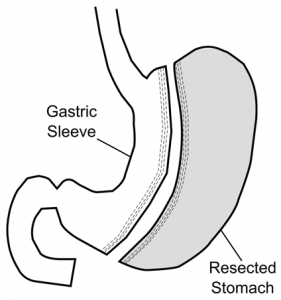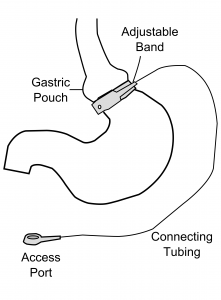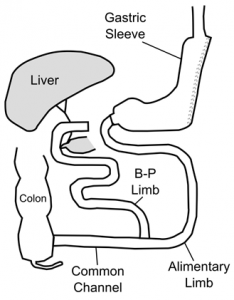Sleeve Gastrectomy
Roux-en-Y Gastric Bypass
Adjustable Gastric Band
Duodenal Switch (BPD-DS)
Types of Operations
Bariatric surgery is not “one-size-fits-all!” The best operation for you may be different from the best operation for someone else. When you come in for you for your visit, your surgeon will talk to you about many different things. What is your weight now? What is your target weight? What other medical problems do you have? Do you have diabetes? Do you have reflux (GERD)? The answers to these questions will help you and your surgeon determine which operation is best for you.
The different operations are shown here on the left.
Sleeve Gastrectomy
Sleeve gastrectomy is now the most common bariatric operation done worldwide. In the sleeve gastrectomy, the left side of the stomach is removed, leaving a long, narrow, banana-shaped stomach.
Gastric Bypass (also called “Roux-en-Y or RNY Gastric Bypass”)
Gastric bypass is the second-most-common operation. First, the surgeon uses a stapler to separate the stomach into 2 parts which creates a small stomach pouch that is completely separated from the lower, bypassed part of the stomach. The small intestine is then surgically divided and reconnected in a Y-shape, and one arm of the Y is connected to the stomach pouch.
Laparoscopic Adjustable Gastric Band
The laparoscopic adjustable gastric band is more commonly called by its trademark name, the LAP-BAND®. Sometimes it is simply called “the band.” In the gastric band, an adjustable plastic doughnut is wrapped around the stomach, limiting the how much food can pass through. Although the gastric band was a very common operation 10-15 years ago, it now represents the least common of the bariatric operations, for a number of different reasons.
Duodenal Switch (DS), or Biliopancreatic Diversion with Duodenal Switch (BPD-DS)
The duodenal switch sometimes goes by the complicated name “biliopancreatic diversion with duodenal switch.” It is commonly referred to by its initials: DS, or BPD-DS. The simple way to think of this operation is that it is like a sleeve gastrectomy and gastric bypass combined. It is a very powerful operation, in that it results in excellent weight loss and control of diabetes. However, is also has more complications and side effects than any other bariatric operation. For this reason it is the least-commonly performed bariatric operation. Of note, Mount Sinai was the first program in the world to perform this operation using minimally invasive surgical techniques, back in 1999.




